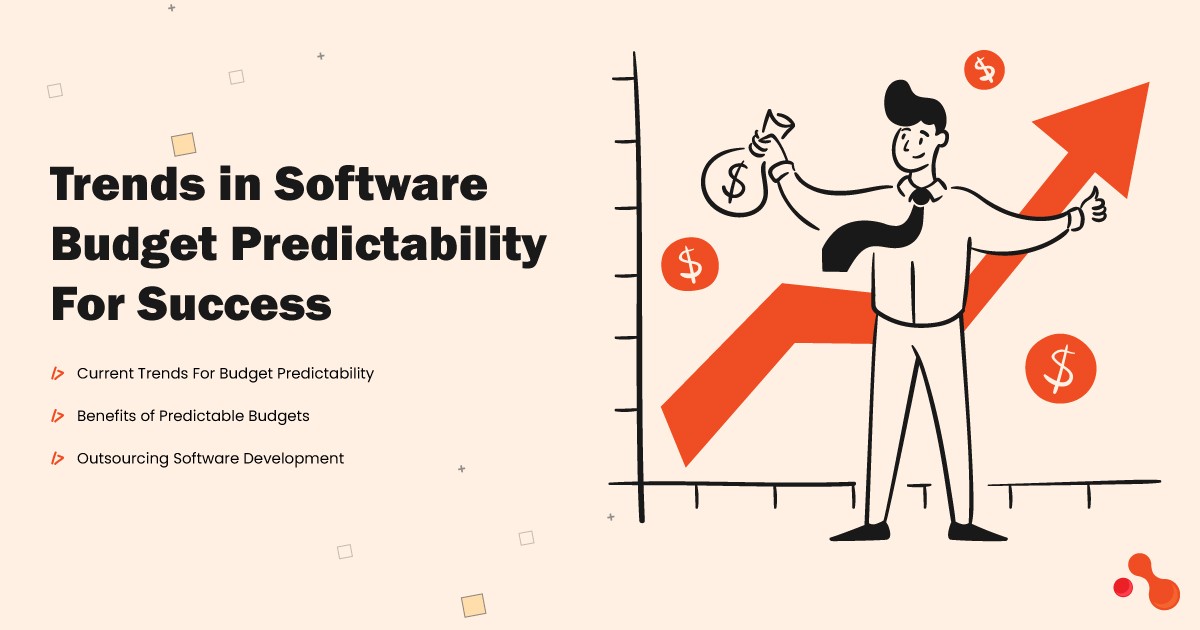
Trends in Software Budget Predictability For Success
Introduction
One of the biggest challenges in software development projects is to estimate the cost and time. Budget predictability is a cornerstone of successful software development, allowing organizations to plan effectively, allocate resources efficiently, and minimize financial risk.
Many factors can affect the budget, such as changing requirements, technical complexity, unforeseen risks, team productivity, and customer feedback. How can software developers and managers achieve budget predictability and avoid cost overruns and delays? In an industry characterized by rapid innovation and change, staying abreast of ongoing trends in budget management is essential.
In this article, we will explore the trends and best practices that can help software teams achieve budget predictability.
Trends For Budget Predictability

Shift to Agile Frameworks: Agile methodologies have transformed the software development landscape, emphasizing flexibility, collaboration, and iterative progress. By breaking down projects into manageable units and integrating regular feedback loops, Agile frameworks significantly enhance budget predictability.
Continuous Delivery and Integration: Continuous delivery and integration practices allow for frequent, incremental updates, reducing the likelihood of significant budget overruns. These practices ensures detection and fixing of the issues early. This serves the purpose of more accurate budget forecasts.
Leveraging Data Analytics and Machine Learning: Data analytics tools are increasingly helpful to predict project costs accurately. By analyzing historical data, these tools can identify patterns and forecast potential budget overrun, enabling proactive adjustments.
Machine Learning for Risk Assessment: Machine learning algorithms can assess project risks. They do so by evaluating factors such as team performance, project complexity, and market conditions. This helps organizations anticipate and mitigate factors that could impact the budget.
Automation of Repetitive Tasks: Automation is a critical component of DevOps. This reduces the likelihood of human error and freeing up resources for more critical tasks. Automating repetitive, time-consuming tasks can lead to more predictable project timelines and costs.
Scalable and Flexible: Cloud-based environments are more scalable and flexible. They allow teams to adjust resources based on real-time demands. This is crucial for maintaining budget predictability in the face of changing project requirements.
Regular Budget Reviews: Frequent budget reviews enable teams to monitor progress, identify variances, and adjust strategies accordingly. These reviews are essential for detecting early signs of budget deviation and implementing corrective measures.
Skill Enhancement: Investing in training and professional development can enhance team efficiency and productivity. This leads to more predictable project outcomes and costs. Skilled employees are better equipped to identify potential issues, propose innovative solutions, and adhere to project budgets.
Data-Driven Decision-Making: Leveraging data analytics and metrics provides insights into project progress, resource usage, and potential risks. Data-driven decision-making helps in identifying patterns and making informed adjustments to maintain budget predictability.
Predictive Analytics and AI: The use of predictive analytics and artificial intelligence (AI) in project management tools enables better forecasting of project timelines and costs. Machine learning algorithms can analyze historical data to predict potential budget challenges.
Real-Time Collaboration Tools: Enhanced collaboration tools facilitate real-time communication among team members and stakeholders. This transparency contributes to a better understanding of project progress and potential deviations from the budget.
Benefits of Predictable Budgets

Predictable budgets provide a stable foundation for organizations, offering financial clarity, risk mitigation, client satisfaction, and improved decision-making. This stability is fundamental to achieving long-term success and sustaining growth.
Here are some key advantages:
They allow for more accurate long-term financial planning.
Can allocate resources more efficiently.
More effective risk management.
Instill confidence in stakeholders.
Empower leaders to make more informed and strategic decisions.
Teams can streamline their processes and operations.
Better cost control with the ability to monitor expenditures closely.
It is simpler to identify areas of overspending or inefficiency.
Simplifies the process of implementing corrective measures to stay within the budgetary limits.
Creates a sense of accountability among team members.
Provide a stable foundation that allows organizations to adapt more effectively to changes.
Promotes financial transparency within the organization.
Outsourcing Software Development

Achieving budget predictability in software development is critical for project success and organizational stability. A good strategy is to hire remote developers and trust them to develop a top-notch solution.
Acquaint Softtech is one such software outsourcing company. We have already delivered over 5000 projects successfully. Take advantage of this and the fact that we have over 10 years of experience delivering flawless solutions.
The expert developers chose to use the trends for their budget in the project Gowd. This aim was to achieve a high level of predictability. We were successful in delivering a cutting-edge solution. Our strategy paid off. We were able to steer clear of budget overrun issues and the client, Vivek Shah was also pleased with the outcome.
Embrace agile methodologies and leverage data analytics organizations can navigate the complexities of budget management in software development.
Some of the other strategies include:
Machine learning
implementing DevOps practices
Adopting cloud-based solutions
Fostering financial accountability
investing in employee training
Utilizing project management software
These trends and best practices provide a robust framework for enhancing budget predictability, ensuring that projects are delivered successfully and sustainably.
As the software development industry continues to evolve, staying informed and adaptable will be key to maintaining financial control and achieving long-term success.